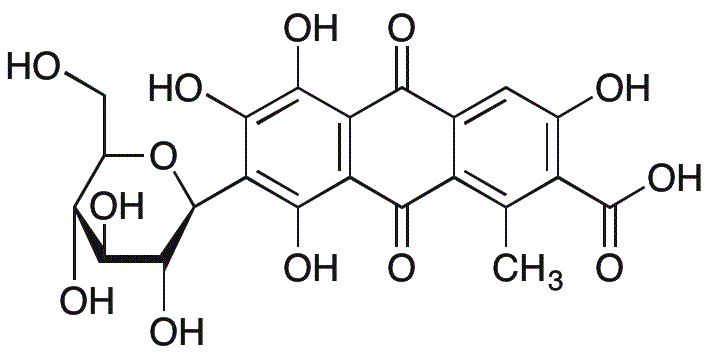Carminic acid is widely utilized in research focused on:
- Natural Dyes: Commonly used in the textile and food industries, carminic acid provides a vibrant red color derived from cochineal insects, making it a popular choice for natural dyeing processes.
- Cosmetics: This compound is often included in cosmetic formulations for its coloring properties, providing a safe and appealing hue in products like lipsticks and blushes.
- Pharmaceuticals: Carminic acid serves as a coloring agent in various medications, enhancing product appeal while ensuring compliance with regulatory standards for safety.
- Biological Research: In laboratories, it is used as a staining agent in microscopy, helping researchers visualize cellular structures and processes more clearly.
- Food Industry: As a natural colorant, it is employed in a variety of food products, offering an alternative to synthetic dyes while meeting consumer demand for natural ingredients.
General Information
Properties
Safety and Regulations
Applications
Carminic acid is widely utilized in research focused on:
- Natural Dyes: Commonly used in the textile and food industries, carminic acid provides a vibrant red color derived from cochineal insects, making it a popular choice for natural dyeing processes.
- Cosmetics: This compound is often included in cosmetic formulations for its coloring properties, providing a safe and appealing hue in products like lipsticks and blushes.
- Pharmaceuticals: Carminic acid serves as a coloring agent in various medications, enhancing product appeal while ensuring compliance with regulatory standards for safety.
- Biological Research: In laboratories, it is used as a staining agent in microscopy, helping researchers visualize cellular structures and processes more clearly.
- Food Industry: As a natural colorant, it is employed in a variety of food products, offering an alternative to synthetic dyes while meeting consumer demand for natural ingredients.
Documents
Safety Data Sheets (SDS)
The SDS provides comprehensive safety information on handling, storage, and disposal of the product.
Product Specification (PS)
The PS provides a comprehensive breakdown of the product’s properties, including chemical composition, physical state, purity, and storage requirements. It also details acceptable quality ranges and the product's intended applications.
Certificates of Analysis (COA)
Search for Certificates of Analysis (COA) by entering the products Lot Number. Lot and Batch Numbers can be found on a product’s label following the words ‘Lot’ or ‘Batch’.
*Catalog Number
*Lot Number
Certificates Of Origin (COO)
This COO confirms the country where the product was manufactured, and also details the materials and components used in it and whether it is derived from natural, synthetic, or other specific sources. This certificate may be required for customs, trade, and regulatory compliance.
*Catalog Number
*Lot Number
Safety Data Sheets (SDS)
The SDS provides comprehensive safety information on handling, storage, and disposal of the product.
DownloadProduct Specification (PS)
The PS provides a comprehensive breakdown of the product’s properties, including chemical composition, physical state, purity, and storage requirements. It also details acceptable quality ranges and the product's intended applications.
DownloadCertificates of Analysis (COA)
Search for Certificates of Analysis (COA) by entering the products Lot Number. Lot and Batch Numbers can be found on a product’s label following the words ‘Lot’ or ‘Batch’.
*Catalog Number
*Lot Number
Certificates Of Origin (COO)
This COO confirms the country where the product was manufactured, and also details the materials and components used in it and whether it is derived from natural, synthetic, or other specific sources. This certificate may be required for customs, trade, and regulatory compliance.


